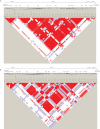Influence of SLCO1B3 haplotype-tag SNPs on docetaxel disposition in Chinese nasopharyngeal cancer patients
- PMID: 21995462
- PMCID: PMC3376437
- DOI: 10.1111/j.1365-2125.2011.04123.x
Influence of SLCO1B3 haplotype-tag SNPs on docetaxel disposition in Chinese nasopharyngeal cancer patients
Abstract
What is already known about this subject: SLCO1B3 is an influx transporter located at the hepatocyte basolateral membrane and it is involved in the uptake of a broad range of drug substrates including docetaxel. The pharmacogenetics of SLCO1B3 is not well characterized and previous in vivo and in vitro studies reported conflicting results with regards to the functional effects of the limited number of SLCO1B3 polymorphisms that were studied. Docetaxel displays a wide interindividual variability in its pharmacokinetics and pharmacodynamics and an understanding of SLCO1B3 pharmacogenetics might provide clinical benefits in guiding docetaxel dosing.
What this study adds: The SLCO1B3 gene was comprehensively screened in the local healthy Asian populations (n= 168). A strong linkage disequilibrium pattern was detected across a total of 88 polymorphisms and 15 haplotype-tag SNPs (htSNPs) were identified. These htSNPs were profiled in a cohort of Chinese nasopharyngeal cancer (NPC) patients (n= 50). Genotypic-phenotypic analysis showed that a haplotypic construct comprising of four variants [IVS4+76G>A, 699G>A(Met233Ile), IVS12-5676A>G, and *347_*348insA] was the critical determinant of docetaxel disposition. This study suggests that the comprehensive screening and haplotypic linkage analysis of SLCO1B3 can better elucidate its pharmacogenetic effects on interpatient variability of docetaxel and other putative drug substrates. Further studies are warranted in cancer patients belonging to other ethnic groups. AIMS To completely screen the SLCO1B3 gene in three distinct healthy Asian populations (Chinese, Malay and Indian, n= 168) and investigate the influence of haplotype-tag SNPs (htSNPs) on docetaxel disposition in 50 nasopharyngeal carcinoma patients.
Methods: Genomic DNA of individuals was screened for SLCO1B3 polymorphisms by direct sequencing. htSNPs were derived based on the sequence clustering algorithm and profiled in the patients. Population based genetic association analysis was performed using Haplostats package implemented in R and PLINK.
Results: A strong linkage disequilibrium pattern was detected across a total of 88 polymorphisms and 15-htSNPs were identified. The SLCO1B3 haplotypic region comprising seven htSNPs was found to be significantly associated with docetaxel clearance (P= 0.003). Conditional haplotype analyses revealed that the haplotypic constructs comprising the IVS4+76G>A, 699G>A(Met233Ile), IVS12-5676A>G, and *347_*348insA polymorphisms were critical determinants of variability in docetaxel disposition [clearance and area under the plasma concentration-time curve (AUC(0,∞)): r(2) = 29% and 22%, respectively]. Patients harbouring the GAG*347insA haplotype were significantly associated with a 30% decrease in clearance and a 40% increase in AUC(0,∞) of docetaxel compared with patients harbouring the reference haplotype, GGA*347wt (P= 0.025 and 0.018, respectively). In contrast, a 50% higher clearance was observed in patients carrying the GAG*347wt haplotype compared with those with the reference haplotype (P= 0.002). The functional SLCO1B3 haplotypic constructs included the widely studied Met233Ile variant and *347_*348insA located in the putative miR-890 binding site in the 3'-untranslated region which may influence the transport characteristics of SLCO1B3.
Conclusions: This study highlights the importance of SLCO1B3 polymorphic variations in influencing docetaxel disposition in nasopharyngeal carcinoma patients.
© 2011 The Authors. British Journal of Clinical Pharmacology © 2011 The British Pharmacological Society.
Figures





References
-
- König J, Cui Y, Nies AT, Keppler D. Localization and genomic organization of a new hepatocellular organic anion transporting polypeptide. J Biol Chem. 2000;275:23161–8. - PubMed
-
- Hagenbuch B, Meier PJ. The superfamily of organic anion transporting polypeptides. Biochim Biophys Acta. 2003;1609:1–8. - PubMed
-
- Smith NF, Marsh S, Scott-Horton TJ, Hamada A, Mielke S, Mross K, Figg WD, Verweij J, McLeod HL, Sparreboom A. Variants in the SLCO1B3 gene: interethnic distribution and association with paclitaxel pharmacokinetics. Clin Pharmacol Ther. 2007;81:76–82. - PubMed
-
- Smith NF, Acharya MR, Desai N, Figg WD, Sparreboom A. Identification of OATP1B3 as a high-affinity hepatocellular transporter of paclitaxel. Cancer Biol Ther. 2005;4:815–8. - PubMed
Publication types
MeSH terms
Substances
LinkOut - more resources
Full Text Sources
Molecular Biology Databases

